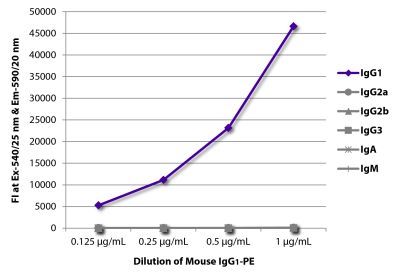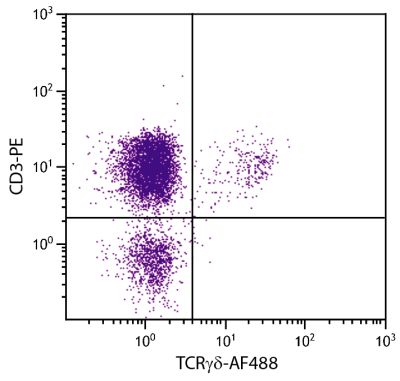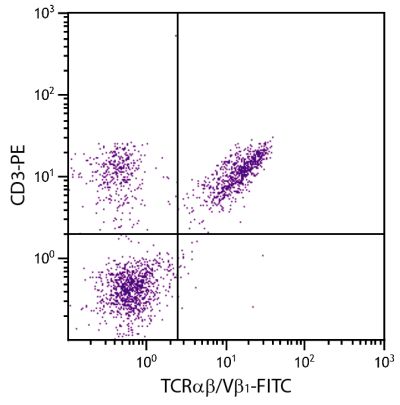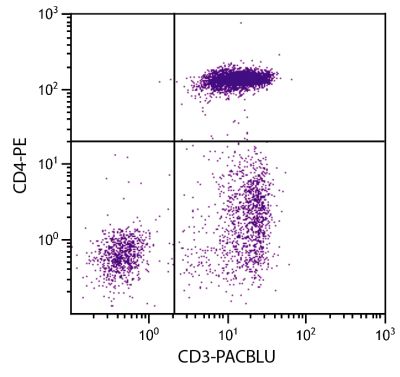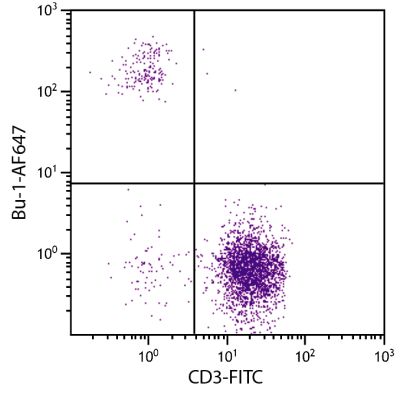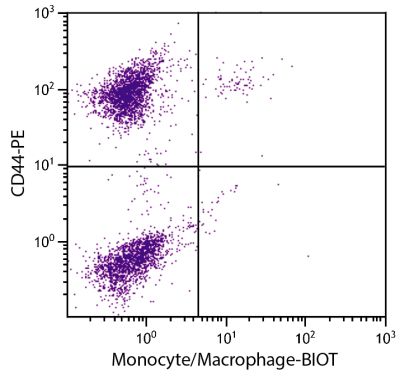Mouse Anti-Chicken TCRαβ/Vβ2-PE (TCR-3)
Cat. No.:
8250-09
PE Anti-Chicken TCRαβ/Vβ2 antibody for use in flow cytometry assays.
$249.00


| Clone | TCR-3 |
|---|---|
| Isotype | Mouse (BALB/c) IgG1κ |
| Isotype Control | Mouse IgG1-PE (15H6) |
| Specificity | Chicken/Peacock/Guinea Fowl TCRαβ/Vβ2 |
| Alternative Names | T3/TCR complex, TCR alpha/beta |
| Description | The monoclonal antibody TCR-3 precipitates a CD3-associated heterodimer of Mr 88 kDa (two bands of Mr 48 kDa and 40 kDa upon reduction) on chicken peripheral blood T cells. Deglycosylation of the heterodimer yields two polypeptides of Mr 34 kDa and 31 kDa. In the chicken, two distinct subpopulations of αβ T cells appear in the thymus subsequent to the appearance of γδ T cells. These subpopulations, originally denoted as TCR-2 and TCR-3, arise sequentially in the thymus during ontogeny and are now known to represent two distinct Vβ families, Vβ1 and Vβ2, respectively. The TCR-3 monoclonal antibody reacts with approximately 9% of thymocytes, 15-25% of blood mononuclear cells, and 13% of splenocytes young adult chickens. Two-color immunofluorescence has revealed that the TCR-3+ thymocytes include CD4+CD8-, CD4-CD8+, CD4+CD8+, and CD4-CD8- subpopulations. The TCR-3+ thymocytes can be separated into two subsets. One subset is characterized by relatively low levels of expression of the TCR-3/CD3 complex and most of the cells in this subset are CD4+CD8+. Cells in the other subset express TCR-3/CD3 in higher density and are either CD4+CD8- or CD4-CD8+, corresponding to the more mature medullary subset of thymocytes. The TCR-3+] cells in the blood and spleen express relatively high levels of the TCR-3/CD3 receptor complex and are “single positive” with CD4+CD8- cells being four times more frequent that the CD4-CD8+ cells (~ 80% CD4+ vs ~ 20% CD8+). |
| Immunogen | CD3+ TCR1- TCR2- Ia- chicken blood mononuclear cells |
| Conjugate | PE (R-phycoerythrin) |
| Buffer Formulation | Phosphate buffered saline containing < 0.1% sodium azide and a stabilizer |
| Clonality | Monoclonal |
| Concentration | 0.1 mg/mL |
| Volume | 1.0 mL |
| Recommended Storage | 2-8°C; Avoid exposure to light; Do not freeze |
| Applications |
Flow Cytometry – Quality tested 1,3-7 Immunohistochemistry-Frozen Sections – Reported in literature 1,2 Immunoprecipitation – Reported in literature 1 Depletion – Reported in literature 1 |
| RRID Number | AB_2796461 |
Documentation
Certificate of Analysis Lookup
Enter the Catalog Number and Lot Number for the Certificate of Analysis you wish to view
- 1. Char D, Sanchez P, Chen CH, Bucy RP, Cooper MD. A third sublineage of avian T cells can be identified with a T cell receptor-3-specific antibody. J Immunol. 1990;145:3547-55. (Immunogen, FC, IP, Depletion, IHC-FS, Peacock and Guinea Fowl Reactivity)
- 2. Gaunson JE, Philip CJ, Whithear KG, Browning GF. Lymphocytic infiltration in the chicken trachea in response to Mycoplasma gallisepticum infection. Microbiology. 2000;146:1223-9. (IHC-FS)
- 3. Koskinen R, Göbel TW, Tregaskes CA, Young JR, Vainio O. The structure of avian CD5 implies a conserved function. J Immunol. 1998;160:4943-50. (FC)
- 4. Peters MA, Browning GF, Washington EA, Crabb BS, Kaiser P. Embryonic age influences the capacity for cytokine induction in chicken thymocytes. Immunology. 2003;110:358-67. (FC)
- 5. Bridle BW, Julian R, Shewen PE, Vaillancourt J, Kaushik AK. T lymphocyte subpopulations diverge in commercially raised chickens. Can J Vet Res. 2006;70:183-90. (FC)
- 6. Zechmann M, Reese S, Göbel TW. Chicken CRTAM binds nectin-like 2 ligand and is upregulated on CD8+ αβ and γδ T lymphocytes with different kinetics. PLOS One. 2013;8(12):e81942. (FC)
- 7. Schusser B, Collarini EJ, Yi H, Izquierdo SM, Fesler J, Pedersen D, et al. Immunoglobulin knockout chickens via efficient homologous recombination in primordial germ cells. Proc Natl Acad Sci USA. 2013;110:20170-5. (FC)
See All References


